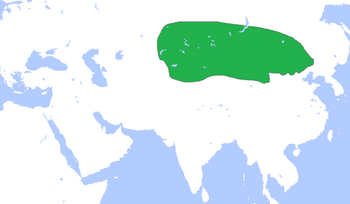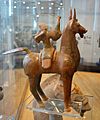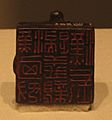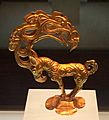Xiongnu facts for kids
Quick facts for kids
Xiongnu
|
|
|---|---|
| 3rd century BC–460s | |

Territory of the Xiongnu (green), circa 250 BC
|
|
| Capital | Longcheng (龙城/蘢城), near Khoshoo Tsaidam (present-day in Mongolia), was established as the annual meeting place and de facto capital. |
| Religion | possibly Tengriism |
| Chanyu | |
| History | |
|
• Established
|
3rd century BC |
|
• Disestablished
|
460s |
The Xiongnu (Chinese: 匈奴) were a group of nomads. They lived north of China for a long time. This was from about the 3rd century BC to the 5th century AD. Their lands were not very fertile, so they often raided China.
To stop these attacks, the first emperor of China, Qin Shi Huang, built the Great Wall of China. This huge wall was built around 214 to 206 BC. Some emperors of the Han dynasty tried to make peace with the Xiongnu. However, the Xiongnu still often attacked the Chinese borders.
Many people once thought the Xiongnu were related to the Huns. Some still believe this today. In ancient times, nomadic tribes often traveled and lived together. This happened even if they spoke different languages. Around 60 BC, the Xiongnu faced a power struggle. They split into five smaller tribes because of this.
In 202 AD, the leader of the Southern Xiongnu gave up to Prime Minister Cao Cao. Cao Cao was a powerful figure of the Han dynasty.
Today, some Xiongnu descendants are part of the Mongolian people. Others have moved to China to find a better life.
Contents
Xiongnu Territory and Influence
The Xiongnu controlled a large area in Central Asia. Their power changed over time. At their strongest, they had a big impact on their neighbors.
How Far Did the Xiongnu Empire Reach?
Under their leader Modu Chanyu, the Xiongnu empire grew very large. This was around 205 BC. Their domain stretched across vast steppes. They influenced many other groups in Asia.
Xiongnu and Other Asian Peoples
The Xiongnu lived alongside many other groups. Maps from around 1 AD show their location. They were a major power in the region. Their presence shaped the history of Central Asia.
Life and Culture of the Xiongnu
The Xiongnu were skilled horse riders and archers. Their way of life was centered around their animals. They moved with their herds to find new pastures.
What Was Xiongnu Daily Life Like?
Xiongnu people were experts at riding horses. They used bows and arrows while on horseback. This made them very strong warriors. They lived in portable homes called yurts. These could be moved easily.
Art and Objects of the Xiongnu
Archaeologists have found many interesting items from the Xiongnu. These include beautiful gold objects. They also found embroidered carpets. These items show their unique art style. Some carpets show people in different clothes.
Xiongnu Leadership and Symbols
The Xiongnu had chiefs who led their tribes. These leaders sometimes received special items. For example, a bronze seal was given by the Eastern Han government. This seal showed a connection between the Xiongnu and the Han dynasty.
The Xiongnu and the Han Dynasty
The relationship between the Xiongnu and the Han dynasty was complex. It involved both conflict and attempts at peace.
Conflicts and Peace Efforts
The Han dynasty often fought with the Xiongnu. The Great Wall was built to protect China. However, there were also times of peace. The Han emperors sometimes tried to make treaties. They even sent gifts to the Xiongnu leaders.
The Split of the Xiongnu Tribes
Around 60 BC, the Xiongnu faced internal problems. This led to them splitting into different groups. The Southern Xiongnu later became allies with the Han dynasty. The Northern Xiongnu continued to move westward.
The End of the Xiongnu Empire
By 200 AD, the Xiongnu were divided. The Southern Xiongnu were in closer contact with China. The Northern Xiongnu were further away. Eventually, the Xiongnu as a unified power faded away. Their people mixed with other groups.
Images for kids
-
Domain and influence of Xiongnu under Modu Chanyu around 205 BC
-
A Han Chinese glazed ceramic figurine of a mounted horse archer, 50 BC to 50 AD, late Western or early Eastern Han Dynasty
-
The Han dynasty world order in AD 2.
-
Southern and Northern Xiongnu in 200 AD, before the collapse of the Han Dynasty.
-
Men in Iranian dress on embroidered carpets from the Xiongnu Noin-Ula burial site. They have also been proposed to be Yuezhi. 1st century BC - 1st century AD.
-
Gold stag with eagle's head, and ten further heads in the antlers. An object inspired by the art of the Siberian Altai mountain, possibly Pazyryk, unearthed at the site of Nalinggaotu, Shenmu County, near Xi'an, China. Possibly from the "Hun people who lived in the prairie in Northern China". Dated to the 4th-3rd century BC, or Han Dynasty period. Shaanxi History Museum.
See also
 In Spanish: Xiongnu para niños
In Spanish: Xiongnu para niños











